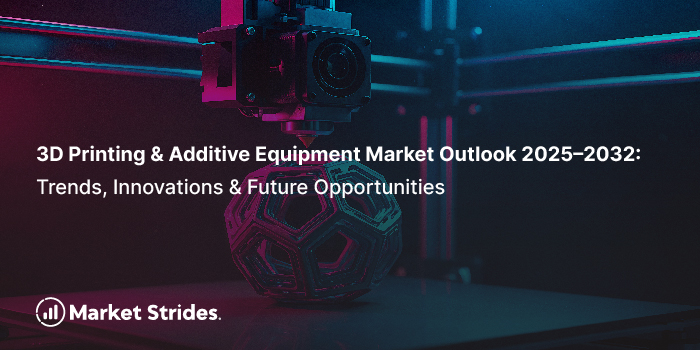3D Printing & Additive Equipment Market Outlook 2025–2032: Trends, Innovations & Future Opportunities

3D Printing & Additive Equipment
3D printing and additive manufacturing have moved well beyond prototyping. Today, they are fundamental technologies driving advanced manufacturing, digital production, customized healthcare, lightweight automotive parts, aerospace innovation and industrial-scale fabrication. As industries shift toward faster, flexible and cost-effective production models, additive equipment is becoming a core component of the global manufacturing ecosystem.
What Is Driving the Growth of 3D Printing & Additive Equipment?
The rise of 3D printing stems from several structural changes in manufacturing. Industries worldwide are seeking:
- Shorter production cycles with rapid prototype-to-product timelines
- Customization at scale — from medical implants to automotive interiors
- Lightweighting for aerospace and mobility applications
- Material efficiency and reduced waste
- Localized manufacturing to limit supply chain risks
Additive equipment enables all of this by offering precision, flexibility and lower upfront tooling costs compared to traditional subtractive manufacturing.
Key Market Segments in 3D Printing & Additive Equipment
1. Industrial 3D Printers
Industrial-grade 3D printers are designed for high-speed, high-strength production. These include metal printers, polymer systems, ceramic printers and hybrid manufacturing tools combining additive and CNC machining. Their rising adoption in aerospace, automotive, defense and tooling applications is a major market growth driver.
2. Desktop and Professional Printers
Professional printers bridge the gap between consumer and industrial systems. Used in design studios, R&D labs and educational institutions, they support prototyping, low-volume manufacturing and product development testing.
3. Metal Additive Manufacturing Equipment
Metal AM is one of the fastest-growing segments as industries shift toward titanium, aluminum, stainless steel and superalloy components. Applications range from jet engine parts and medical implants to precision automotive components.
4. Additive Manufacturing Software
Software drives the additive ecosystem through design optimization, simulation, slicing and workflow management. Advanced software enables topology optimization, lattice generation and automated quality control for production environments.
5. Materials & Consumables
Materials represent a major recurring revenue stream. Key categories include:
- Metal powders (steel, titanium, Inconel)
- Engineering polymers (PA12, ABS, PEEK, PEKK)
- Composite filaments
- Resins for SLA/DLP systems
- Ceramic and bio-compatible materials
Industry Adoption: Who Is Using 3D Printing?
Aerospace & Defense
Aerospace companies use 3D printing for lightweight structural parts, engine components, ducting, brackets and cabin interior parts. Additive equipment supports both prototyping and certified end-use production.
Automotive & Mobility
Automotive players leverage AM for rapid tooling, custom components, motorsport upgrades, lightweight structures and EV thermal management systems. Additive processes reduce production time and support design flexibility.
Healthcare & Medical Devices
3D printing has transformed medical manufacturing with:
- Patient-specific implants
- Customized prosthetics
- Surgical planning models
- Dental aligners & lab equipment
Industrial Manufacturing & Tooling
Factories use AM for custom jigs, fixtures, molds and replacement parts. This reduces machine downtime and speeds up operations in lean manufacturing environments.
Consumer Goods & Electronics
Additive technologies support highly customized wearables, fashion accessories, luxury goods and low-volume electronics casings.
Technological Trends Reshaping the Additive Market
1. Shift Toward Production-Scale Additive Manufacturing
Companies are transitioning from prototyping to full-scale additive production lines. High-throughput printers, robotic automation and smart manufacturing workflows are enabling continuous production.
2. Multi-Material & Multi-Process Printing
Printers are evolving to handle multiple materials — metals, polymers, ceramics — and hybrid systems combine additive and subtractive processes inside one machine.
3. AI-Enhanced Design & Quality Control
Machine learning optimizes part design, predicts structural behavior, identifies defects and enhances consistency in production environments.
4. Advancements in Metal Powder Production
New atomization techniques and improved powder recycling systems are lowering material costs and improving part consistency.
5. Sustainable & Circular Manufacturing Models
AM reduces waste, enables part reuse and supports localized production, helping companies advance sustainability goals.
Market Opportunities (2025–2032)
1. Additive Tooling for Factories
Manufacturers increasingly require rapid tooling, fixtures, molds and spare parts. Additive tooling is one of the highest-ROI applications.
2. Growth of Metal AM in Aerospace, Medical & Automotive
Demand for titanium and high-performance metal printed parts continues to grow across high-value industries.
3. Customization at Scale
Healthcare, consumer goods, dental labs and industrial users are driving large-scale custom manufacturing using digital workflows.
4. Regional Manufacturing Hubs
Countries investing in local production (India, China, Europe, U.S.) are accelerating adoption of industrial and metal AM systems.
5. AM Service Bureaus & On-Demand Manufacturing Centers
Specialized service bureaus offering prototyping, small-batch manufacturing and metal printing continue to expand globally.
Conclusion
3D printing and additive equipment are reshaping how products are designed, developed and manufactured. With rapid adoption across aerospace, medical devices, automotive, consumer goods and industrial sectors, the market is entering its most transformative growth phase. As materials, software and equipment continue to evolve, additive manufacturing will become an increasingly central part of global production systems.